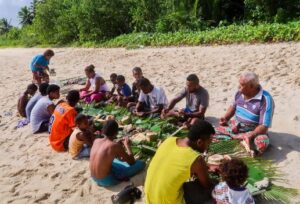
Family of Susana Yalikanacea (an organic producer from Fiji) enjoying organic and nutritious lunch by the beach in their village.
In simple terms food and nutritional security refers to the ease of access and availability of healthy and nutritious food to every human being at all times.
Industrial or commercial agriculture currently claims itself to be the sole solution to increase food security producing more and more manufactured foods and turning towards genetically modified crops to improve yields.
Due to a number of complex factors however many people still remain hungry and or malnourished. These factors include the high cost of some manufactured foods and the increasing reliance on a farming system that is dependent on external purchased inputs – including seeds.
Traditionally the Pacific Islands have maintained food security though traditional mixed cropping practices ensuring diversity of crops, resilient production systems and care of the soil and environment.
While Pacific small holders still provide a large degree of food security for our communities it is coming increasingly under threat due to:
- Rapid population growth is leading to increases in demand for food resources and land for residential and other purposes
- The impact of Climate Change and more extreme weather conditions such as tropical cyclones and drought on agricultural, coastal areas and fresh water quality
- Urbanization is leading to limited land in urban areas to grow healthy nutritious vegetables/foods and increased usage of frozen and processed food by urban communities
- The impact of mass media and advertising has contributed to a shift in consumption from traditional staple and fresh local foods to processed foods
- Reliance on imported foods is increasing, the sometimes poor nutritional quality is increasing the risk of ‘lifestyle’ or non-communicable diseases
- As increasing amount of food are purchased low incomes and unemployment reduces household access to adequate safe, nutritious food
- Economic shocks lead to increases in food and fuel costs which puts more stress on low household budgets especially in urban areas.
Therefore there is an urgent need to increase the efficiency of present resource use and at the same time conserve and where possible enhance the productive capacity of our agricultural resources.

Pacific organic staple foods
Organic Agriculture can play a major role in addressing food security as a means of alleviating poverty and ensuring an adequate and stable food supply for most of the population in our region.
These are some of the ways in which Organic agriculture helps sustain Food security:
- Organic agriculture can increase and stabilize yields particularly in land which is less productive or marginal
- Building capacity in organic farm management can assist farmers, and producers to build resource management skills
- Increased organic production can improve availability and affordability of clean, safe local foods to our diet contributing to controlling NCD’s and other diseases
- Unemployment can be reduced by providing jobs in the organic agricultural sector and enable cash poor households to obtain enough good quality food to eat well in some settings organic agriculture can provide up to 32% more jobs per farm than conventional farms[1]
- Organic systems are more resilient to climate change and extreme weather events, for example organic farms survive cyclone damage much better, retaining 20 to 40% more topsoil and smaller economic losses at highly significant levels than their neighbors[2]
- Organic systems improve water uptake, retention and soil erosion to overcome land aridity/desertification. A 2003 study found that during drought years, organic farms can have yields 20-40% higher than conventional farms[3]
- Ensure availability and sustainability of resources for future generations to come
Agriculture based on organic principles has now been recognized as an important aspect in overcoming poverty and enhancing food security.
[1] Soil Association.(2006) Organic Works. Providing jobs through organic farming and local food supply. Bristol; the Soils Association
[2] A study of 1,804 organic farms in Central America hit by Hurricane Mitch: Holt-Gimenez, E. (2000)
[3] Lotter, D. W., Seidel, R. & Liebhardt W. (2003). “The performance of organic and conventional cropping systems in an extreme climate year”. American Journal of Alternative Agriculture 18 (3): 146–154

